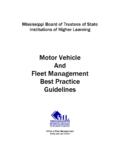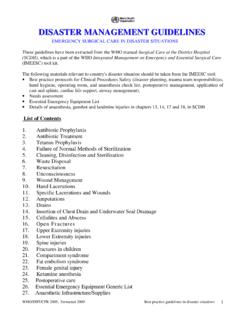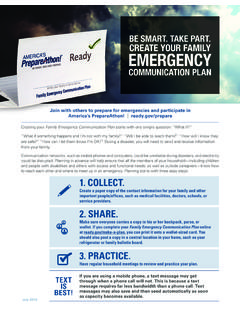Transcription of AFRAMEWORK FOR MAJOR EMERGENCY …
1 A FRAMEWORK FOR. MAJOR EMERGENCY management . A Framework enabling An Garda S och na, the Health Service Executive and Local Authorities to prepare for and make a co-ordinated response to MAJOR emergencies resulting from events such as fires, transport accidents, hazardous substance incidents and severe weather. Contents A Framework for MAJOR EMERGENCY management PREFACE 9. ACKNOWLEDGEMENTS 10. SECTION 1 - INTRODUCTION TO THE FRAMEWORK 11. Background to the Framework for MAJOR EMERGENCY management 11. Purpose of the Framework 11. Structure of the Framework 12. Scope of the Framework 13. Defining a MAJOR EMERGENCY 15. Principles Underpinning the Framework 15. The Systems Approach to MAJOR EMERGENCY management 16.
2 Common Language and Terminology 18. Delivering the Framework 18. SECTION 2 - HAZARD ANALYSIS / RISK ASSESSMENT 20. Introduction 20. Carrying out a Risk Assessment 20. The Risk Assessment Methodology 21. Stage 1 Establishing the Context 22. Stage 2 Hazard Identification 23. Stage 3 Risk Assessment 23. Stage 4 Recording Potential Hazards on a Risk Matrix 24. Using the Risk Assessment 24. SECTION 3 MITIGATION / RISK management 27. Introduction 27. Prioritising Areas for Mitigation 27. Implementing Mitigation Measures 27. Co-ordination of Mitigation Efforts 28. Promoting Resilience 29. Resilient Communities 29. Resilient Services 30. Critical Infrastructure Protection 30. 1. SECTION 4 - PLANNING AND PREPAREDNESS 32.
3 Introduction 32. MAJOR EMERGENCY Plans 32. Preparing and Updating MAJOR EMERGENCY Plans 32. The MAJOR EMERGENCY Plan Format 32. Functions of the Principal Response Agencies 34. Regional Level Co-ordination 35. Regional Preparedness Arrangements 35. Plans for Regional Level Co-ordination 36. Linking the MAJOR EMERGENCY Plan with National EMERGENCY Plans 37. Linking the MAJOR EMERGENCY Plan with Other EMERGENCY Plans 38. Severe Weather Plans 38. Site and Event-Specific EMERGENCY Plans 40. Ports and Harbours 40. Airports 41. Preparing to Respond 41. MAJOR EMERGENCY Development Programmes 41. Leadership in MAJOR EMERGENCY management 41. Scoping the Agency's Preparedness 42. Key Roles and Support Teams in MAJOR EMERGENCY Response 43.
4 Sub-Plans/Procedures/Code Instructions for Functions 44. Staff Development, Training and Exercise Programmes 44. Development of Staff for MAJOR EMERGENCY management Roles 44. Assignment of Staff to MAJOR EMERGENCY management Roles 45. Agency Training Programmes 46. Exercises 46. A Joint Approach to Training and Exercises 47. Third Party Exercises 47. Resource Issues 48. Resources for Preparedness 48. Procurement and Resources for Response 48. 2. MAJOR EMERGENCY Preparedness Appraisal 49. Undertaking an Appraisal 49. Assessment Tools 49. Review and Validation of the Appraisal 50. SECTION 5 DELIVERING A CO-ORDINATED RESPONSE 51. Introduction 51. Declaring the MAJOR EMERGENCY 51. Initial Mobilisation 52. Command, Control and Co-ordination of Response 53.
5 Command and Control Arrangements on Site 53. Controller of Operations 54. Co-ordination Arrangements 55. Introduction 55. The Lead Agency Concept 56. Exercising the Co-ordination Role 58. Decision-Making Mandates 59. Delivering the Co-ordination Role 59. On-Site Co-ordination 60. Local Co-ordination Groups 60. Crisis management Teams 61. Regional Co-ordination Groups 62. Linking with National Level Co-ordination 63. Information management Systems 64. Purpose of Information management 64. The Information management Cycle 65. Information management Officers 66. A Generic Information management System 66. Developing the Action Plan 67. Communications 67. Public Information 67. The Media 68. Communications Systems (Technical) 68.
6 3. Site management 69. Developing a Site management Plan 69. Identification of Personnel 70. Review of Initial Approach to Scene management 71. Danger Area 72. Aerial Support and Helicopters 73. Air Exclusion Zones 73. Mobilising Additional Resources 74. Introduction 74. Mutual Aid 74. Regional Level Emergencies 74. Assistance from Other Organisations/Agencies 74. The Defence Forces 75. Civil Defence 75. The Irish Red Cross 75. The Voluntary EMERGENCY Services Sector 76. Utilities 76. The Private Sector 76. Integrating Casual Volunteers into the Response 77. Extra-Region/National/International Assistance 78. Northern Ireland 79. Integrating and Managing Support and Assistance 79. Casualties and Survivors 80. The Injured 80.
7 Fatalities 82. Survivors 83. Casualty Bureau 83. Friends' and Relatives' Reception Centres 83. Vulnerable Persons 84. Non-National Casualties 84. Pastoral and Psycho-Social Care 84. 4. Managing Hazardous Materials Incidents 85. Normal Hazardous Materials Incidents 85. CCBRN Incidents 85. Decontamination 86. Protecting Threatened Populations 87. Introduction 87. Public Health Services 87. Evacuation 89. Weather Forecasts 90. Safety, Health and Welfare Considerations 90. Investigations 90. VIPs/Observers 91. Standing Down the MAJOR EMERGENCY 92. The Status of the EMERGENCY 92. Standing Down Individual Services 92. Operational Debrief 92. SECTION 6 RECOVERY 93. Introduction 93. Functions in the Recovery Phase 93.
8 Co-ordination of the Recovery Phase 94. Emerging Issues 94. Common Themes in Recovery 94. Support and Care of Victims 95. Restoring Normality 95. Managing Resources 95. Staff Welfare 95. Media 95. VIP Visits 95. Managing the Direct Financial Implications 95. Economic Impact 96. Litigation (Legal/Criminal) 96. Hardship Relief Schemes 96. Liaison with the Insurance Industry 96. 5. LIST OF FIGURES. Figure Five-Stage EMERGENCY management Paradigm Figure Schematic of Risk Assessment Process Figure A Risk Matrix Figure (a) The Risk Matrix Zones Figure (b) The Risk Matrix Zones Figure Using the Risk Assessment as a Basis for Mitigation Figure Linking MAJOR EMERGENCY Plans with National Plans and Other Plans Figure Schematic Diagram Illustrating Command, Control and Co-ordination Levels and Information Flows Figure Information management Cycle Figure Typical Site management Arrangement Figure Managing Hazardous Materials Incidents Figure Structure of Evacuation LIST OF TABLES.
9 Table The Generic Information management System 6. APPENDICES TO THE FRAMEWORK. (See separate book of Appendices). Appendix F1 - The Principal Response Agencies Appendix F2 - The National Steering Group Appendix F3 - Glossary of Terms and Acronyms Appendix F4 - MAJOR EMERGENCY management at Regional Level Appendix F5 - Functions of the Principal Response Agencies Appendix F6 - Weather Forecasts and Public Service Severe Weather Warnings Appendix F7 - Designation of Lead Agency Appendix F8 - Decision-Making Mandates Appendix F9 - Co-ordination Centres Appendix F10 - Information management Systems Appendix F11 - Site management Arrangements Appendix F12 - Identification of Personnel at the Site of a MAJOR EMERGENCY Appendix F13 - Procedures for Mobilising External Resources Appendix F14 - Fatal Casualties 7.
10 8. Preface MAJOR EMERGENCY management is a key challenge and a priority issue for Government. Clearly, the world in which we live is constantly changing and we need to develop our MAJOR EMERGENCY management architecture to enable us to deal effectively with the possibility of new risks and threats. In the last few years most European Countries have engaged in review and development of their MAJOR EMERGENCY or civil protection arrangements. This new Framework for MAJOR EMERGENCY management moves in line with international trends in this field. The publication of this document marks the culmination of an extensive process of consultation and development. The development of the new Framework was overseen and validated by independent international consultants.









